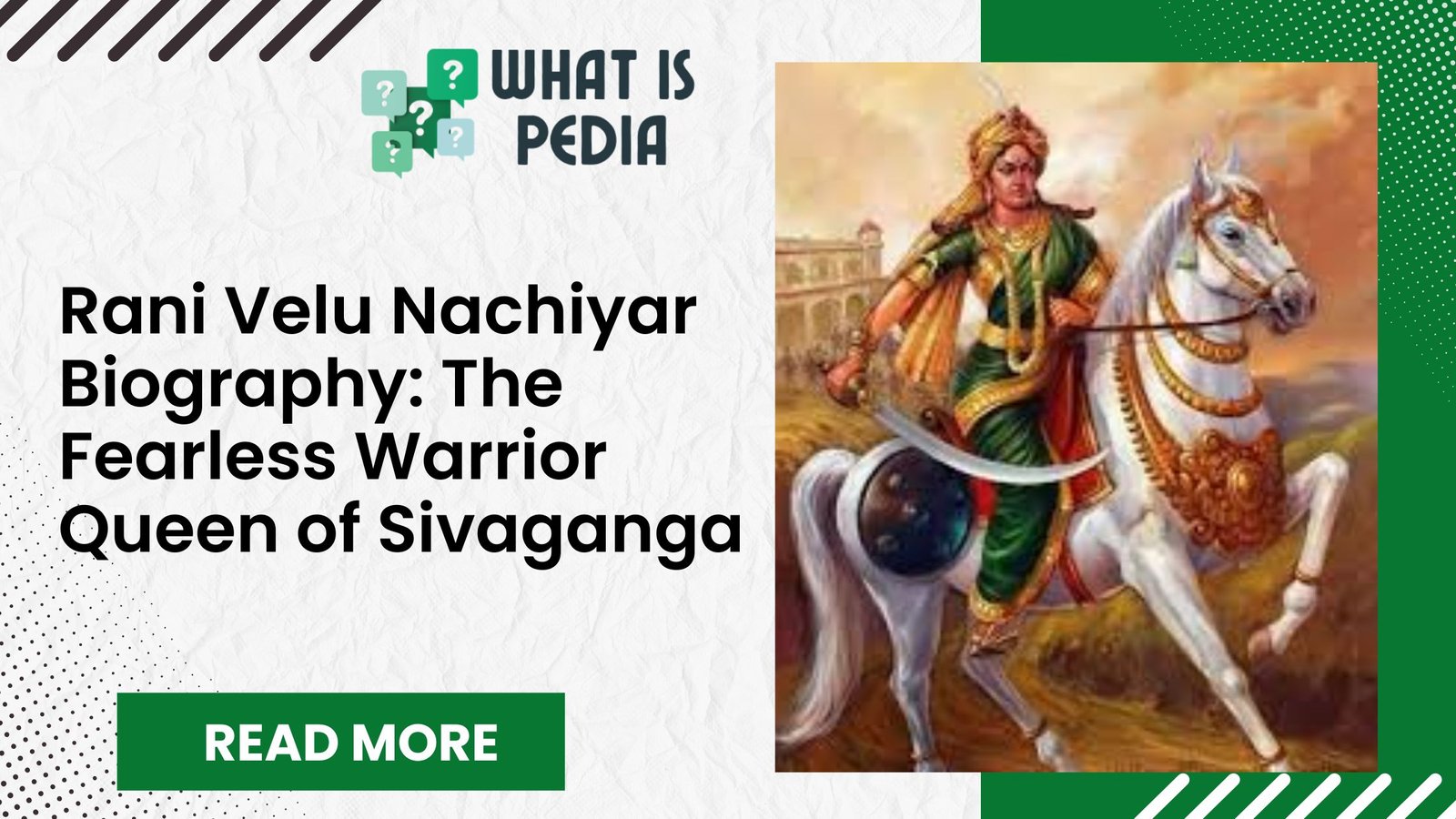1. Introduction
Rani Velu Nachiyar, the queen of Sivaganga, holds a significant place in Indian history as the first female ruler to wage war against British colonial rule. Born in the 18th century, she defied the gender norms of her time and emerged as a symbol of courage, resilience, and patriotism. Her life story is not just a tale of royalty but an inspiring saga of resistance and empowerment.
In an era when the British East India Company was expanding its influence across the Indian subcontinent, Velu Nachiyar stood as a formidable force. Her strategic mind, military prowess, and undying spirit made her a trailblazer in India’s fight for freedom. Unlike many rulers of her time, she didn’t succumb to British dominance but instead organized a well-planned revolt, reclaiming her kingdom from colonial forces.
This blog delves deep into the extraordinary life of Rani Velu Nachiyar, exploring her early years, rise to power, struggle against the British, and the legacy she left behind. From her education in warfare to her alliance with Hyder Ali and the formation of an all-women army, every chapter of her life showcases her indomitable spirit.
By the end of this blog, you’ll understand why Rani Velu Nachiyar is celebrated as a pioneer of India’s independence movement and why her story continues to inspire generations. Let us embark on this journey to honor the fearless warrior queen of Sivaganga.
2. Early Life and Background
Rani Velu Nachiyar was born in 1730 in the Ramnad Kingdom, located in present-day Tamil Nadu. She was the only daughter of Raja Chellamuthu Vijayaragunatha Sethupathi and Rani Sakandhimuthal. Being the sole heir to the throne, she received exceptional care and attention from her parents, who ensured that her upbringing was not confined to traditional female roles.
From an early age, Velu Nachiyar exhibited signs of leadership and intelligence. Her education was diverse and comprehensive, covering subjects like Tamil, Sanskrit, and Urdu. Additionally, she was trained in the arts of warfare, including horse riding, archery, and sword fighting. Her father, a visionary ruler himself, believed that a true leader should be well-versed not only in statecraft but also in the art of defense.
Velu Nachiyar’s intellectual prowess was equally impressive. She was fluent in multiple languages, including English and French, which would later prove invaluable in her diplomatic and military pursuits. Her exposure to politics and governance from a young age shaped her into a well-rounded leader.
The influence of her upbringing was evident in her leadership style. She was compassionate yet firm, strategic yet empathetic. This unique combination of qualities made her stand out among her contemporaries and laid the foundation for her future as a revolutionary queen.
3. Marriage and Political Life
Rani Velu Nachiyar was married to Muthuvaduganatha Periya Udaiyathevar, the ruler of the Sivaganga Kingdom. Their marriage was not just a union of two individuals but also a strategic alliance that strengthened the political standing of both kingdoms. As queen, Velu Nachiyar actively participated in the administration and governance of Sivaganga, showcasing her keen interest in political affairs.
Unlike many queens of her time, Velu Nachiyar did not remain confined to the palace. She worked alongside her husband, understanding the intricacies of state administration and military strategy. Her involvement in governance earned her the respect of both the court and the common people.
During this period, the British East India Company and the Nawab of Arcot were expanding their influence in Tamil Nadu. The British sought control over resource-rich regions, while the Nawab acted as a regional power broker. Sivaganga, under the rule of Muthuvaduganatha Periya Udaiyathevar, resisted these external pressures, maintaining its sovereignty.
However, this resistance made Sivaganga a target for British aggression. The growing conflict between the British, the Nawab of Arcot, and the local rulers set the stage for the tragic events that would soon unfold in Velu Nachiyar’s life.
4. The Tragedy and Exile
The turning point in Rani Velu Nachiyar’s life came in 1772 when the British, in alliance with the Nawab of Arcot, launched an attack on Sivaganga. The kingdom, despite its fierce resistance, could not withstand the combined might of the British forces and the Nawab’s army.
In the brutal onslaught, Muthuvaduganatha Periya Udaiyathevar was assassinated, and the kingdom of Sivaganga fell into the hands of the invaders. The loss of her husband and kingdom was a devastating blow, but Velu Nachiyar’s spirit remained unbroken.
Fearing for her life and that of her young daughter Vellachi, Rani Velu Nachiyar escaped with the help of her trusted aides, including her loyal commander Kuyili and the confidant Thandavarayan Pillai. Together, they sought refuge in Dindigul, where they found protection under Hyder Ali, the ruler of Mysore.
Hyder Ali, impressed by Velu Nachiyar’s courage and resilience, extended his support. He provided her with a safe haven and resources to rebuild her army. This period of exile was not one of despair but of preparation and determination. Velu Nachiyar vowed to reclaim her kingdom and avenge the loss of her husband.
5. Alliance with Hyder Ali and Military Preparation
During her exile in Dindigul, Rani Velu Nachiyar forged a crucial alliance with Hyder Ali, one of the most powerful rulers of South India. Hyder Ali, known for his opposition to British expansion, saw in Velu Nachiyar a kindred spirit. He not only provided her with asylum but also extended military support to help her reclaim her kingdom.
Under Hyder Ali’s patronage, Velu Nachiyar began rebuilding her forces. She organized a well-structured army, consisting of both men and women. One of her most remarkable contributions to military history was the formation of an all-women regiment, the first of its kind in India. This regiment, led by her trusted commander Kuyili, underwent rigorous training in combat, espionage, and guerrilla warfare.
Velu Nachiyar also ensured that her army was equipped with advanced weaponry and strategic knowledge. She worked closely with Hyder Ali’s generals, learning new military tactics and adapting them to her cause. The collaboration between Hyder Ali’s forces and Velu Nachiyar’s army created a formidable front against the British.
With her army ready and her strategy in place, Rani Velu Nachiyar prepared to launch her counterattack and reclaim the Sivaganga Kingdom.
6. Battle Against the British
The year 1780 marked the beginning of Rani Velu Nachiyar’s campaign against the British East India Company. With the support of Hyder Ali and her newly formed army, she launched a series of strategic attacks aimed at destabilizing British control over Sivaganga.
One of the most significant aspects of her military strategy was her use of guerrilla warfare. Unlike traditional battles, guerrilla tactics involved surprise attacks, ambushes, and sabotage, making it difficult for the British to counter her moves.
The most iconic moment of this campaign was the “Human Bomb” strategy executed by Kuyili. In a daring act of bravery, Kuyili doused herself in oil, set herself on fire, and charged into the British ammunition depot, destroying their supplies and weakening their defense. This act of sacrifice turned the tide in Velu Nachiyar’s favor.
With the British forces crippled and their resources depleted, Rani Velu Nachiyar led her army into Sivaganga and successfully reclaimed her kingdom. It was a historic victory, marking the first successful revolt by an Indian ruler against British colonial rule.
7. Rule and Administration
After reclaiming the Sivaganga Kingdom, Rani Velu Nachiyar focused on rebuilding her administration and strengthening her defenses. Her rule was characterized by progressive policies aimed at ensuring the welfare of her people.
Velu Nachiyar implemented several socio-economic reforms, including the promotion of education, agriculture, and trade. She ensured that the kingdom’s economy was revitalized and that the people regained their livelihoods after years of conflict.
In terms of military administration, she continued to maintain a strong defense force, including the all-women regiment. Her governance was marked by a balance between compassion and firmness, ensuring that justice prevailed in her kingdom.
Despite her victory, Velu Nachiyar remained vigilant against further British interference. She strengthened alliances with neighboring kingdoms and maintained diplomatic ties to protect her kingdom’s sovereignty.
8. Legacy and Death
Rani Velu Nachiyar ruled Sivaganga with wisdom and strength until her death in 1796. Her reign was not just a period of political stability but also one of cultural and social progress.
Her legacy extended beyond her lifetime, inspiring future freedom fighters like Rani Lakshmibai of Jhansi. Velu Nachiyar’s strategic brilliance, courage, and unwavering resistance against colonial rule made her a symbol of empowerment and patriotism.
In modern times, she has been honored through various tributes. The Indian government released a postage stamp in her honor, and statues commemorating her bravery stand tall in Tamil Nadu. Documentaries, books, and academic studies continue to celebrate her contributions to India’s freedom struggle.
9. Conclusion
Rani Velu Nachiyar’s life is a testament to the power of resilience, intelligence, and unwavering courage. As the first Indian queen to fight against British colonialism, she paved the way for future struggles for independence.
Her ability to lead an army, form strategic alliances, and reclaim her kingdom from one of the world’s most powerful empires is nothing short of extraordinary. Velu Nachiyar’s legacy lives on, not just in history books but in the hearts of those who value freedom and justice.
As we remember her contributions, it is essential to recognize her as more than just a regional ruler—she was a national hero whose spirit continues to inspire generations. May her story remind us that true leadership is defined not by power but by the courage to stand up for what is right.
Rani Velu Nachiyar’s legacy remains immortal, a shining beacon in the annals of Indian history.







